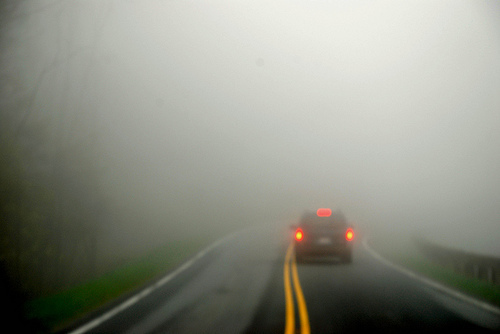
Winter weather isn’t always just about snow and ice. In some areas of the United States, the temperatures are moderate enough for no snow, but fog can be a common occurrence. Foggy conditions can be just as dangerous as snow and ice storms, mostly due to significantly limiting visibility. When fog rolls in, even if you’re a veteran driver, driving can become difficult.
Yes, even deadly.
In summary, fog is condensed water vapor that normally occurs close to the ground. Fog happens when warmer air interacts with cold air. The cold air can hold less water vapor than the warm air, so the water vapor condenses into liquid water to form fog. Dense fog can create dangerous road conditions, made even more so if coupled with other severe weather conditions.
Naturally, the safest thing to do is pull over into a parking area until the fog clears.
According to the U.S. Department of Information, based on a 10-year average (2007-2016), with fog as the road weather condition, 25,451 crashes represented 1% of vehicle crashes. From that number, 8,902 persons were injured (1% of crash injuries) and 464 persons were killed, representing 2% of crash fatalities.
However, if you must continue and this simply isn’t an option, here are some tips for when you must be on the road driving in that dreaded “pea soup”:
Be Distraction-Free
First, minimize distractions, as in, be distraction-free. Because the weather itself is a major distraction, you want to eliminate anything else that could be taking your attention. Keep the radio off, so you can listen for other cars. Stay off the phone, even if you have a hands-free device. The more you can focus on actually driving, the safer you’ll be.
Adjust your lights
When fog hits, visibility is restricted, and a driver’s natural reaction is to flip on those high-beam headlights. However, when visibility is restricted due to foggy conditions outside, the high beams can do more harm than good. In fog, high beams actually reflect off the fog and back at the car, which makes visibility even more restricted. Instead, use your low beam headlights or fog lights, if your vehicle has them. Make sure that you are never turning off your lights completely--it’s the best way for other cars to see you. If your car is equipped with fog lights, use them. Fog lights are typically mounted lower than your regular headlights, sometimes even below the bumper, and are aimed at the ground in front of the car.
Reduce speed, increase following distance
Since you’re already having difficulty seeing the roadway or oncoming vehicles, lowering your speed can help your reaction time. Reduce your speed and increase following distance. When visibility is restricted, it’s crucial to slow down. You never know when another car or something else may appear seemingly out of nowhere, and if you’re driving too fast, you may not have enough time to react properly.
If you can’t avoid the fog altogether, the first thing you should do is to increase the distance between your car and the car in front of you. In good weather, you want a 2-second distance. When driving through fog, you should up the distance to 5 seconds.
Utilize your speedometer
Make sure that you’re utilizing your speedometer to monitor your speed, as driving in fog can create a sort of optical illusion that makes your body think you are driving slowly. While driving, you don’t want to take your eyes off the road too much, but make a conscious effort to glance at the speedometer every now and then to ensure you’re not speeding.
Use the pavement lines
When fog is dense, the risk of driving off the road or into the other lane can be high. To combat this, use the right-side pavement line as a guide and follow it with your eyes (without fixing them on it). Make sure you’re using the right side as opposed to the center line, which may make you inch closer to oncoming traffic, whose vision is also impaired.
Stopping
In dense fog, you may feel unsafe being on the road and it’s perfectly acceptable to stop and wait until visibility improves. However, stopping in fog can cause a whole slew of other problems. Remember that if you are stopping because visibility is that bad, cars will likely not be able to see you! The best place to stop is in a driveway, parking lot or rest area. If you must stop on the side of the road, pull off as far as possible, even onto the grass. Stay put with your seat belt on and turn your lights off, otherwise cars may think you are still driving and you run the risk of getting rear ended. Remember, in the worst fog, stopping should be a last resort.
Beware of animals
Because they can’t see you from far off, animals tend to feel more comfortable walking on the road when it’s foggy. And because you can’t see them, there’s less time to react, which causes a significant increase in roadkill--and vehicular accidents.
Black Ice
When it’s foggy and the temperatures are freezing, black ice can occur, and as you most likely learned in driver’s ed, it’s extremely dangerous. Black Ice is a very thin, dark sheet of ice that is difficult to see in good visibility, and nearly impossible to see when it’s foggy.
Dense fog doesn’t always last a long time, so pulling over safely may help visibility improve and you can be on your way quickly. Stay safe!
